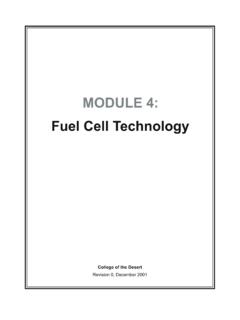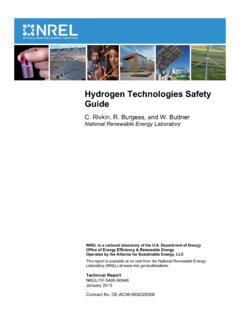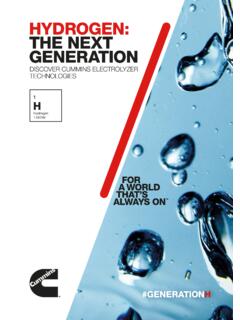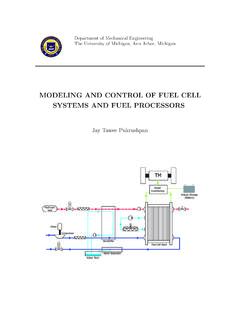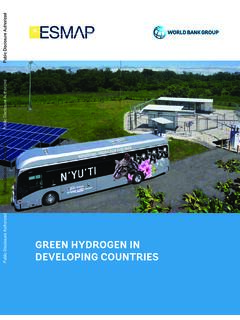Transcription of Hydrogen Fuel Cells Fact Sheet
1 Hydrogen fuel Cells H2. DOE Hydrogen Program Overview the fuel 's energy corresponding to more than a 50% reduction in fuel consumption, compared Hydrogen is a versatile energy carrier that can be used to a conventional vehicle with a gasoline internal to power nearly every end-use energy need. The fuel combustion engine. cell an energy conversion device that can efficiently capture and use the power of Hydrogen is the key to 4In addition, fuel Cells operate quietly, have fewer making it happen. moving parts, and are well suited to a variety of applications. 4 Stationary fuel Cells can be used for backup power, power for remote locations, distributed power generation, and cogeneration (in which excess How Do fuel Cells Work?)
2 Heat released during electricity generation is used A single fuel cell consists of an electrolyte sandwiched for other applications). between two electrodes, an anode and a cathode. Bipolar 4 fuel Cells can power almost any portable application plates on either side of the cell help distribute gases that typically uses batteries, from hand-held devices and serve as current collectors. In a Polymer Electrolyte to portable generators. membrane (PEM) fuel cell, which is widely regarded as the most promising for light-duty transportation, Hydrogen 4 fuel Cells can also power our transportation, including gas flows through channels to the anode, where a catalyst personal vehicles, trucks, buses, and marine vessels, causes the Hydrogen molecules to separate into protons and as well as provide auxiliary power to traditional electrons.
3 The membrane allows only the protons to pass transportation technologies. Hydrogen can play a through it. While the protons are conducted through the particularly important role in the future by replacing the imported petroleum we currently use in our cars and trucks. A Single fuel Cell Why fuel Cells ? e . e e . e . 4 fuel Cells directly convert the chemical energy in . e H2 e . Hydrogen to electricity, with pure water and potentially Hydrogen H2. useful heat as the only byproducts. e . e . 4 Hydrogen -powered fuel Cells are not only pollution- free, but also can have two to three times the efficiency of traditional combustion technologies. A conventional combustion-based power plant O2.
4 H+. typically generates electricity at efficiencies of 33. to 35 percent, while fuel cell systems can generate H+ O2 Oxygen H+. electricity at efficiencies up to 60 percent (and even Bipolar Plate Bipolar Plate higher with cogeneration). Electrolyte Cathode The gasoline engine in a conventional car is less Anode than 20% efficient in converting the chemical energy O2. in gasoline into power that moves the vehicle, under normal driving conditions. Hydrogen fuel cell vehicles, which use electric motors, are much Water H2O. + Heat more energy efficient and use 40-60 percent of 5 3 $EPARTMENT OF %NERGY (YDROGEN 0 ROGRAM. WWW Hydrogen ENERGY GOV. Hydrogen Fuels Cells membrane to the other side of the cell, the stream of negatively-charged electrons follows an external circuit to the cathode.)
5 This flow of electrons is electricity that can be used to Did you know . do work, such as power a motor. Hydrogen is an energy carrier, On the other side of the cell, oxygen gas, typically drawn from the outside air, flows not an energy source, meaning through channels to the cathode. When the electrons return from doing work, they react with oxygen and the Hydrogen protons (which have moved through the membrane ) at the that it stores and delivers cathode to form water. This union is an exothermic reaction, generating heat that can be energy in a usable form. used outside the fuel cell. Hydrogen can be produced using The power produced by a fuel cell depends on several factors, including the fuel cell type, abundant and diverse domestic size, temperature at which it operates, and pressure at which gases are supplied.
6 A single energy resources, including fossil fuel cell produces approximately 1 volt or less barely enough electricity for even the fuels, such as natural gas and smallest applications. To increase the amount of electricity generated, individual fuel Cells coal; renewable energy resources, are combined in series to form a stack. (The term fuel cell is often used to refer to the such as solar, wind, and entire stack, as well as to the individual cell.) Depending on the application, a fuel cell stack may contain only a few or as many as hundreds of individual Cells layered together. biomass; and nuclear energy. This scalability makes fuel Cells ideal for a wide variety of applications, from laptop Using Hydrogen as a form of computers (50-100 Watts) to homes (1-5kW), vehicles (50-125 kW), and central power generation (1-200 MW or more).
7 Energy can not only reduce our dependence on imported oil, but Comparison of fuel Cell Technologies also benefit the environment by reducing emissions of In general, all fuel Cells have the same basic configuration an electrolyte and two greenhouse gases and criteria electrodes. But there are different types of fuel Cells , classified primarily by the kind of pollutants that affect our air electrolyte used. The electrolyte determines the kind of chemical reactions that take place quality. in the fuel cell, the temperature range of operation, and other factors that determine its most suitable applications. The President's Hydrogen fuel Initiative accelerates the Operating fuel Cell Type System Output Efficiency Applications research and development Temperature of fuel Cells and Hydrogen Alkaline (AFC) 90 100 C 10kW 100kW 60 70% electric Military 194 212 F Space production, storage, and delivery Phosphoric Acid 150 200 C 50kW 1MW 80 85% overall with combined heat Distributed generation infrastructure technologies (PAFC) 302 392 F (250kW module typical) and power (CHP) (36 42% electric)
8 Needed to support Hydrogen fuel Polymer Electrolyte 50 100 C <250kW 50 60% electric Back-up power Cells for use in transportation membrane or 122 212 F Portable power and electricity generation. Proton exchange Small distributed generation membrane (PEM)*. Transportation Under the President's Hydrogen Molten Carbonate 600 700 C <1MW 85% overall with CHP (60% electric) Electric utility fuel Initiative, the DOE. (MCFC) 1112 1292 F (250kW module typical) Large distributed generation Hydrogen Program works with Solid Oxide (SOFC) 650 1000 C 5kW 3 MW 85% overall with CHP (60% electric) Auxiliary power industry, academia, national 1202 1832 F Electric utility laboratories, and other federal Large distributed generation and international agencies to Source: Argonne National Laboratory overcome critical technology *Direct Methanol fuel Cells (DMFC) are a subset of PEMFCs typically used for small portable power applications with a size range of about a subwatt to 100W and operating at 60 90 C.
9 Barriers, address safety issues and facilitate the development Challenges and Research Directions of model codes and standards, Reducing cost and improving durability are the two most significant challenges to fuel cell validate Hydrogen fuel cell commercialization. fuel cell systems must be cost-competitive with, and perform as well technologies in real world or better than, traditional power technologies over the life of the system. conditions, and educate key stakeholders who can facilitate Ongoing research is focused on identifying and developing new materials that will reduce the cost and extend the life of fuel cell stack components including membranes, catalysts, the use of Hydrogen and fuel cell bipolar plates, and membrane -electrode assemblies.
10 Low cost, high volume manufacturing technology. processes will also help to make fuel cell systems cost competitive with traditional technologies. Increase Your H2IQ! Visit For print copies of this fact Sheet , please call the DOE Energy Efficiency and October 2006. Renewable Energy Information Center at 877-EERE-INF(O)/877-337-3463.
